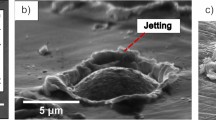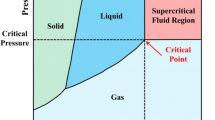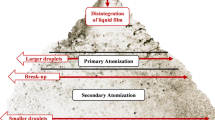Abstract
The influence of liquid pressures and orifice diameters on the sprayability of non-Newtonian, waterborne latex coatings, that vary in latex particle size and thickener composition are examined in this study. It is observed that the higher the dynamic uniaxial extensional viscosities (DUEVs, ηe) of the coatings, the larger the Sauter mean diameters (SMDs) of the spray droplets and the broader the droplet size distributions. The shear viscosities at high shear rates and the parameter reflecting shear elasticity, the storage moduli, at low deformation rates do not correlate with the droplet sizes and the distributions observed. In addition to these observations, the Sauter mean diameters of spray droplets decrease with increasing spray pressures and with decreasing orifice diameters; however, with increasing pressures, pulsations in the fluid due to turbulence create areas of high and low droplet density.
The relationship of the SMD to orifice diameters using fan nozzles is defined by the relationship:\(SMD/d_h = 5.5[\sigma \eta _e ^4 /(p_A d_h ^3 \Delta P_L ^2 )]^{0.25} + 2[\sigma p_L /(p_A d_h \Delta P_L )]0.25\)
The experimental results associated with each of these parameters are discussed in the text.
Similar content being viewed by others
References
Levinson, S.B., “Application of Paint and Coatings,”Federation Series on Coatings Technology, Federation of Societies for Coatings Technology, Philadelphia, PA, 1988.
McBane, B.N., “Automotive Coatings,”Federation Series on Coatings Technology, Federation of Societies for Coatings Technology, Philadelphia, PA, 1987.
Zink, S.C., inEncyclopedia of Chemical Technology, 3rd Ed., Vol. 6, p. 414, 466, 1983.
Rayleigh, L.,The Theory of Sound, Vol. 2, Dover Publications, New York, (republication of 1896 edn.), pp. 343–75, 1945.
Weber, C.,Z. Angew. Math. Mech., 11(2), 136 (1931).
Masters, K.,Spray Drying, An Introduction to Principles, Operational Practice and Applications, 2nd Ed., John Wiley & Sons, New York, 1976.
Snyder, H.E., Senser, D.W., and Lefebvre, A.H.,ASME J. Fluids Engineering, 111, 342 (1989).
Snyder, H.E., Senser, D.W., and Lefebvre, A.H.,IEE Transactions on Industry Applications, 25 (4), 720 (1989).
Lefebvre, A.H. and Senser, D.W.,Industrial Finishing (June 16, 1990).
Corbeels, P.L., Senser, D.W., and Lefebvre, A.H.,Atomization and Sprays, 2, 87 (1992).
Wang, X.F. and Lefebvre, A.H.,J. Propulsion, 3 (1), 11 (1987).
Xing, Lin-lin, Glass, J.E., and Fernando, R.H., inTechnology for Waterborne Coatings, ACS Symposium Series 633, Glass, J.E. (Ed.), American Chemical Society, Washington, D.C., Chapter 15, 1997.
Plla, S.,J. Oil & Colour Chemists’ Assoc., 56, 195 (1973).
Ginsberg, T.,FATIPEC, 497–502, 1974.
Dorman, J.D. and Stewart, D.M.D.,J. Oil Col. Chem. Assoc., 59, 115 (1976).
Glass, J.E., “Dynamics of Roll Spatter and Tracking Part III: Importance of Extensional Viscosities,”Journal of Coatings Technology,50, No. 641, 56 (1978).
Fernando, R.H. and Glass, J.E.,J. Rheology, 32 (2), 199 (1988).
Strivens, T.A., inPaint and Surface Coatings, Theory and Practice, Lambourne, R. (Ed.), Ellis Horwood Limited Publishers, Chichester, England, Chapter 15, 1988.
Ming-Ren Tarng, M.R., Ma, Z., Alahapperuma, K., and Glass, J.E., inHydrophilic Polymers: Performance with Environmental Acceptability, Advances in Chemistry Series 248, Glass, J.E. (Ed.), American Chemical Society, Washington, D.C., Chapter 24, 1996.
Master, K.,Spray Drying, An Introduction to Principles, Operational Practice and Application, 2nd Ed., John Wiley & Sons Inc., New York, 1976.
Karunasena, A. and Glass, J.E.,Proc. ACS Div. Polymer Materials: Sci. Engin., 56, 627 (1987).
Wang, S.Q., Drda, P.A., and Inn, Y.W.,J. Rheol., 40 (5), 875 (1996).
Elliott, P.T., Ph.D. dissertation, North Dakota State University, in progress.
Author information
Authors and Affiliations
Additional information
Polymers and Coatings Department, Fargo, ND 58105.
Research Development Center, Lancaster, PA 17604.
Rights and permissions
About this article
Cite this article
Xing, Ll., Edward Glass, J. & Fernando, R.H. Parameters influencing the spray behavior of waterborne coatings. Journal of Coatings Technology 71, 37–50 (1999). https://doi.org/10.1007/BF02697898
Issue Date:
DOI: https://doi.org/10.1007/BF02697898




